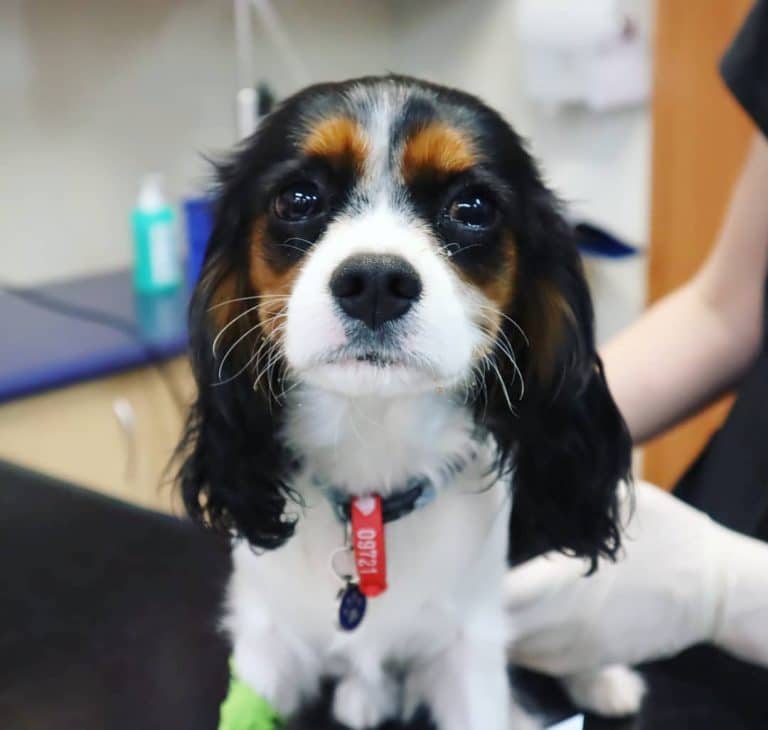What Is A Pet Emergency? (when to go to the emergency vet guide)
Our pets can very easily find themselves in a spot of bother that needs a trip to the vet. It may be because they’ve eaten something they shouldn’t have, had an accident, or fallen ill. But what do you do if your regular vet is closed? Do you wait until morning when they reopen, or do you go to your nearest after hours emergency vet? And what is a pet emergency?
To answer these questions it’s important to know what a pet emergency is and how to recognise one. Our guide will help you identify when your pet needs immediate medical care as well as what to do in emergency situations before arriving at the animal emergency hospital.
In our guide you’ll learn:
- What is a pet emergency?
- Should I go to the emergency vet if my pet has an emergency?
- What should I do in a pet emergency?
- Is there first aid treatment I can give my pet at home?
- How does an emergency vet work?
- How do I prepare for a pet emergency?
What is a pet emergency?
What is considered a pet emergency that needs urgent vet care? Some pet emergencies are obvious, like breathing difficulties and severe bleeding. While other pet crises are hard to recognise.
Remember, no one knows your pet as well as you do. If your pet is acting strangely or something doesn’t seem right, you may have picked up on a subtle sign of a real problem. If ever you’re unsure whether your pet is ill or injured, we recommend calling your local vet for advice. If your local vet is closed, call your nearest emergency vet, and with just a few questions will be able to help you make the decision as to whether your pet needs immediate care or if they can wait until your regular vet opens in the morning.
What are the signs of a pet emergency?
Some pet problems are obvious in needing emergency treatment, while others may go unnoticed until it’s too late. Some of the most common pet emergencies we see in our hospital are listed below. If your pet is experiencing any of the following symptoms or conditions, they will need to see a vet immediately before they become life-threatening.
- Snake bites: If your pet has been bitten by a snake or has been seen near a snake, even if they collapse and seemingly recover urgent treatment is needed.
- Heat stroke: If your pet is panting excessively, feels very warm to touch, or has a high-temperature, they may be suffering from heat stroke.
- Major trauma: This includes traumatic events such as being hit by a car, falling from a height, a cat or dog fight or attack, received a strong kick (like one from a cow or horse), and blunt force. Even if your pet is not showing any signs of injury there can be extensive internal injuries.
- Blood loss: Bleeding that doesn’t stop by itself should be attended by a vet to avoid excessive blood loss. Bleeding from unusual places, blood spots on the skin and bruising can also be signs of certain blood disorders and should be seen by a vet.
- Penetrating wounds: Bite wounds or stab wounds can cause significant internal damage even if the wound looks minor on the surface.
- Evidence of poisoning: Is it possible your pet has been exposed to or ingested something toxic? The list of things which are poisonous to our pets is long and includes human foods, plants, insecticides and pesticides, and medication. For a more in-depth list, visit our Pets and Poisons blog.
- Seizures: While an isolated seizure is unlikely to be life-threatening, seizures lasting for more than 2-3 minutes or having more than 2-3 seizures in a 24-hour period are cause for concern. Seizures can be caused by a number of things and it is recommended your pet should see a vet if they have one.
- Difficulty breathing: Has your pet stopped breathing, having trouble breathing or has noisy breathing? If your pet is showing any signs of breathing difficulty we recommend seeing a vet immediately.
- Swollen or distended abdomen: Swollen, distended and hard abdomens can be a sign of some very serious conditions, such as bloat, otherwise known as GDV (gastric dilation and volvulus) – when the stomach twists. This is an emergency requiring immediate veterinary attention.
- Collapse or weakness: These can be symptoms of serious illnesses and injuries, including internal bleeding, heart failure, and snake bites all of which need immediate veterinary treatment.
- Loss of balance: Is your pet unable to maintain their balance? This can indicate a serious condition requiring immediate treatment.
- Vomiting: A symptom of a number of problems such as pancreatitis, gastrointestinal obstructions, gastrointestinal parasites, infections, ingestion of a toxin, and kidney or liver disease. Repeated vomiting can also very quickly lead to life-threatening dehydration so we recommend seeing a vet as soon as possible.
- Diarrhoea: Like vomiting, the causes of diarrhoea are numerous. It can vary in severity and if prolonged lead to severe dehydration. No matter the severity, treatment will be required.
- Struggling to urinate: Male cats are susceptible to urinary obstructions which are life-threatening. If your male cat is straining to urinate they should see a vet immediately. While straining to urinate is less common in other pets, they should be seen by a vet as this can be caused by bladder stones, urinary obstructions, and urinary tract infections which can be very painful and in some cases life-threatening.
- Not eating and/or drinking: Pets not eating or changes in eating behaviours can be a sign of illness and if prolonged can result in dehydration as they are not meeting their needs.
- Coughing: Can range in severity from on the mild side kennel cough to life-threatening disorders such as heart disease, pneumonia and some bleeding disorders. All pets with a cough should be see a vet.
- Loss of rear legs: This paralysis can be a symptom of spinal injury which require veterinary care.
- Severe pain: If your cat or dog is exhibiting any sign of pain such as vocalising, limping or hiding, treatment should be sought immediately.
- Birthing problems: If you have any concerns about your pet’s pregnancy see your vet for advice. If your pet seems to have problems during labour, medical intervention may be needed.
- Burns and smoke inhalation: Has your pet been burnt or been exposed to a significant amount of smoke?
- Broken bones: History of recent trauma, limping, appearing to be in pain or limbs sitting at a strange angle could be signs of a broken bone.
Although this list doesn’t include every possible pet emergency, it does give a peek into the sorts of situations requiring immediate veterinary care.
Should I go to the emergency vet if my pet has an emergency?
If your pet experiences any of the above conditions or symptoms, they require urgent vet care. Without veterinary treatment, your pet’s condition can quickly progress and become life-threatening.
If your regular vet is closed and you’re unsure whether to wait until morning when they reopen, it’s always better to err on the side of caution. A visit or a call to an after hours emergency vet, even if it turns out not to be a pet emergency, is always worthwhile just for putting your mind at ease. Over the phone, an emergency vet will be able to advise you whether taking your pet to them immediately is best, or if waiting until the morning would be okay. Nothing is ever too small or insignificant for a veterinarian to see or give advice on.
You should never feel anxious about your pet’s health. If you’re concerned about a health issue, our Perth Vet Emergency hospital is fully staffed and open every weeknight, as well as 24 hours on weekends and public holidays. Our team is here to help guide you in determining whether your pet needs to see a veterinarian, as well as to provide first aid advice over the phone. No appointments are needed to see our vets, and there is no need to call us before bringing your pet to us.
What should I do in a pet emergency?
Pet emergencies are stressful experiences. While we all hope our pets will never need emergency care, it’s good to know what to do just in case.
- Keep calm and try not to panic
While it may be hard to do, the best thing is to remain as calm as possible. Not only will this help you to think clearly, it will also help your pet remain calm since they are attuned to our emotions. - Keep your pet calm
Keep your pet as quiet and calm as possible. Try keeping their movements to a minimum, particularly if there is a chance they have any broken bones, spinal injuries or are showing any neurological symptoms. Take care when tending to your pet, if they are in pain or in distress they may become aggressive or bite. - Perform basic pet first aid
If you didn’t see what happened to your pet, search the area for any potential danger to yourself or your pet. You may be able to spot clues as to what happened to your pet, what they interacted with, or what they ate. Once it’s safe to do so, observe your pet’s behaviour and breathing. Depending on the injury your pet has sustained or the symptoms they are displaying, you may also need to check their heart rate or pulse, temperature, and level of consciousness. Before arriving at the vet, you may need to perform basic pet first aid, such as CPR and controlling their bleeding. - Let your emergency vet know you are on your way
If possible, contact your local vet or emergency vet to let them know you are on your way so they may be better prepared for your arrival. - Safely transport your pet to the vet
- Minimise handling: If your pet is conscious, allow them to get comfortable. Encourage large dogs to lie down but don’t force them as they may find the position uncomfortable. For small dogs, use a laundry basket or wrap them in a towel/blanket. Always use carriers for cats.
- Handle with care: Try to avoid rough handling or restraints as it may cause further injury.
- Minimise movement: Pets with severe injuries should be treated as if they have suffered a spinal injury by avoiding spine or neck rotation. For transportation, use a sturdy, flat support surface, such as an ironing board or wardrobe door.
- Recovery position: If your pet is unconscious, keep them in the recovery posture during travel. For the recovery position, place them on their side and tilt their head down slightly if they have a head injury, otherwise tilt their head up.
- Drive with care: Avoid abrupt braking or acceleration. At turns, decrease speed gradually as your pet can further injure themselves trying to maintain their balance.
Is there first aid treatment I can give my pet at home?
Most pet emergencies will need immediate vet care. However, it’s helpful to know some basic pet first-aid treatment you can give your pet straight away at home. These basic treatments will help keep your pet stable so you may transport them safely to the vet and even help save your pet’s life.
How does an emergency vet work?
Once you arrive at an emergency vet, you will be greeted by a nurse who will triage your pet. If your pet has a severe medical emergency, they will be taken directly to the treatment area for further evaluation and stabilisation, and treatments can begin.
For other cases, the emergency veterinarians will treat pets in order of medical priority.
What is a pet blood bank?
Many emergency veterinarians have a pet blood bank as there are many times where the crucial treatment in an emergency is a blood transfusion. More often than not the difference between life and death is this life-saving treatment for patients threatened by illness, trauma, surgery, or poisoning incidents.
Unfortunately, blood has a short lifespan, only being able to be stored for 35 days. Because of this, regular donations from our wonderful blood donors are not only very much appreciated but also very much needed.
To find out if your pet meets the criteria and to register to become a canine blood donor, visit our Blood Donor Program page.
How do I prepare for a pet emergency?
While we hope our pets never experience an emergency, it’s always better to be prepared. To ensure you are ready for an emergency, make sure you:
- Know the phone numbers of your regular vet, closest vet clinic, closest emergency hospital, and pet ambulance.
- Know the address of the regular vet, closest vet clinic, and closest emergency hospital.
- Know how to get to your regular vet, closest vet clinic, and closest emergency hospital. Take the time to do a dry run so you become familiar with the streets and travel time.
- Not all vet clinics have an attending vet at the time they open – find out the starting time for your primary vet.
- Download our Vital Signs Observation List of what to monitor for when your pet becomes unwell.
- Know what is normal for your pet and regularly monitor their health to check for any changes.
- Learn about conditions that may affect your pet. For example, if your pet is pregnant learn about how a normal birth progresses and how to recognise if there is a problem.
- Keep a well-stocked pet first aid kit at home and even one in the car for when you and your pet are out and about.
- Learn how to perform basic first aid, including CPR, how to stop bleeding and how to apply a pressure wrap. Our First Aid Book takes you through how to help your pet for common pet emergencies. There are now a number of in-person and online pet first aid courses available, such as the Australian Red Cross veterinary-approved short online course.
- Plan ahead for financial coverage, such as money kept aside for situations like these or look into pet insurance.
If you believe your dog is ill or injured, visit Perth Vet Emergency or your local veterinarian immediately.



